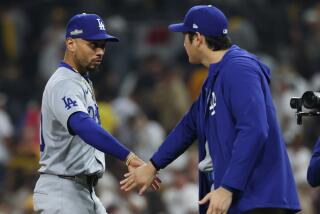Book review: ‘The Extra 2%’
- Share via
The Extra 2%
How Wall Street Strategies Took a Major League Baseball Team From Worst to First
Jonah Keri
Random House: 255 pp., $26
For much of its existence, the Tampa Bay Rays franchise of the American League has been the laughingstock of professional baseball. Inept in the field and particularly so in the front office, the team squandered money and opportunities with astonishing alacrity. Under managing partner Vincent J. Naimoli, extravagant sums were paid to players whose best days were behind them — many of whom flamed-out brilliantly in a Tampa Bay uniform. Under Naimoli’s direction the team consistently made boneheaded selections in the draft and alienated its fan base in a breathtaking range of ways. Torii Hunter, the great Angels outfielder, said he would rather get hit in the head with a Randy Johnson fastball than play for Tampa Bay. “If he hits me, it’s over with,” Hunter said. “But if you play for the Devil Rays, you’re stuck.”
Jonah Keri captures this legacy of ineptitude — much of it well known to fans — in extensive detail in “The Extra 2%: How Wall Street Strategies Took a Major League Baseball Team From Worst to First.” He also outlines the steps that three former denizens of Wall Street took when Naimoli’s stretch of failure came to an end. Led by Stuart Sternberg, who bought controlling interest in the club from Naimoli, they began a process of rebranding the business, changing the team’s name to Tampa Bay Rays (No apparent sympathy here for the Devil?) and worked to rebuild the fan base.
They hired a patient, nonconventional thinker in Joe Madden as manager and started using some of their Wall Street thinking when it came to the high finance of buying and selling players. They brokered an innovative contract with slugger Evan Longoria, believed by many to be the best third baseman in the league. Astonishingly, after never having a winning record in their 10 years of play, the Rays won the American League pennant in 2008, going from last place to first in the tough American League East before losing to the Philadelphia Phillies in the World Series. They won their division again two years later against the Yankees and Red Sox with a fraction of those franchises’ payrolls, a monstrosity of a home stadium — Tropicana Field — and an unpredictable fan base.
Much of Keri’s book covers the low-hanging fruit of the team’s years of ineptitude and provides intriguing details on its turnaround. He makes a good case that the team now has strong management, but knowledgeable fans have to wonder if this recent success might be an aberration. Tampa Bay still plays in the fan-unfriendly “Trop,” and the team lost one of its top players — outfielder Carl Crawford — in the offseason when it couldn’t match the deep pockets of the Red Sox. The Rays signed Johnny Damon and Manny Ramirez, both on the downside of their careers, but for far less than they once squandered under Naimoli. It is too soon to tell if the Rays’ success will stand the test of competitive economics and time.
More to Read
Sign up for our Book Club newsletter
Get the latest news, events and more from the Los Angeles Times Book Club, and help us get L.A. reading and talking.
You may occasionally receive promotional content from the Los Angeles Times.






